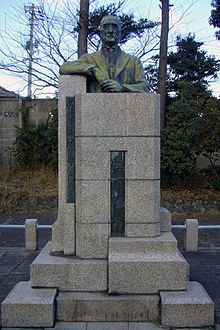Jintan (pills)
Jintan ( Japanese 仁 丹 ) is the name of a popular type of pill developed by Morishita Hiroyoshi ( 森 下 博 ) and marketed since 1905, which was initially considered a prophylactic panacea, but is now only used for oral hygiene and refreshment.
Morishita Hiroshi (1869-1943) was the eldest son of a priest at the Nunakuma Shrine ( 沼 名 前 神社 , Numakuma jinja ) in Fukuyama ( Hiroshima Prefecture ). When the father gave up his office and got involved in the tobacco trade, the nine-year-old son was taken out of school. However, at the age of 15 after his father's death, he went to Osaka , where he founded a drug store in 1893 and also developed his own remedies. He recognized the importance of advertisements early on. For the drug Dokumetsu , developed against venereal diseases , he used a portrait of the Imperial Chancellor Otto von Bismarck, who was also revered in Japan at the time . Morishita produced the first full-page advertisements in Japanese daily newspapers and poster pillars in Osaka and Tokyo, which were called the Jintan Towers ( 仁丹塔 , Jintantō ) at the time. Morishita soon opened up foreign markets from Asia to Central and South America, and set up branches and subsidiaries.
During the Russo-Japanese War , in which the reputation of the victorious military was used by many companies for product advertising, the remedy Jintan was created. It was sold in small bottles, and later also cans, which showed the image of a high-ranking officer in a bicorn hat and a dress uniform. Jintan consists of sixteen ingredients taken from the Chinese pharmacy such as cinnamon , mint , ginger , cloves , caraway , fructus amomi , etc. The name combines the Confucian term jin (humanity) with the term tan ( cinnabar , pills containing cinnabar , pills ), which is particularly used in Daoism general) and evokes the idea of longevity and health.
literature
- Sōgō hokenyaku Jintan kara sōgō hoken sangyō JINTAN e - Morishita Jintan 100nen kinenshi . Osaka: Jintan, 1995.
- Machida Shinobu: Jintan wa naze nigai? Meiji-Taishōki no yakuhin-kōkoku zuhanshū . Tokyo, Borantia jōhō-nettowaaku, 1997.
Web links
- Jintan website (Japanese)
- Jintan Museum (Japanese)
Individual evidence
- ↑ with Bismarck portrait ( Memento from September 15, 2007 in the Internet Archive )
- ↑ More in Morishita Jintan 100nen kinenshi
- ^ Jintan advertisement for the Indian market
- ↑ Machida (1997) offers an extensive collection of remedy displays from the Meiji and Taishō periods .

